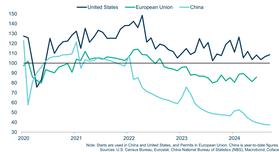Strengths
- Activity generated from persistent rise in urbanisation in the emerging world and undersupply of housing in advanced economies
- Business opportunities, investment, and innovation for companies in the sector, on the back of the energy transition
- Strong push for infrastructure development
Weaknesses
- The level of indebtedness of construction companies remains high, particularly in China
- High household debt at the global level
- Vulnerable to supply chain disruptions and labour shortages
- Cyclical sector, impacted by the global economic growth environment
- High interest rates environment globally
Risk assessment
Executive summary

After several difficult years with weak demand and a challenging operating environment resulting in falling permits and longer backlogs, construction activity is poised to improve in 2025. This rebound is anticipated to be fuelled by lower interest rates, which are expected to boost overall construction activity, particularly in advanced economies, such as in Europe and the U.S. While the environment remains difficult, falling energy prices and stabilising (yet high) building material costs as well as easing labour shortages will support this recovery, contributing to a gradually improving – although still risky – outlook for the sector.
In 2025, the credit environment is expected to improve but will remain challenging. House prices, which had declined in many countries, are beginning to recover and are projected to rise which will help the market but hurt an already serious issue of affordability. Although decreasing interest rates are set to boost activity, with more homes coming to market and prices improving, mortgage rates are anticipated to stay above pre-pandemic levels, which will continue to impact affordability. In this context, persistent economic uncertainty and increasing non-performing loans (NPLs) will likely keep lending practices cautious and the risk environment elevated for the construction sector.
In 2025, several sub-sectors of the construction industry are expected to continue doing relatively better. Civil engineering will remain strong, buoyed by significant government investments, though the rate of new orders is expected to slow. The commercial construction sector shows a mixed performance, but parts are expected to be helped by supportive industrial policies. Meanwhile, repair and maintenance, particularly for energy efficiency projects, will continue to grow robustly, driven by high energy costs and ongoing demand in both the residential and non-residential segments.
In 2025, the construction sector will continue to face familiar challenges despite the aforementioned improvements. The industry remains a major contributor to global carbon emissions, with energy-intensive production (like cement, steel, and glass) generating substantial greenhouse gases. Efforts to decarbonise will require substantial investments, which pose a significant financial burden. Housing affordability remains a pressing issue, with the house-price-to-income ratio still worse than before the pandemic and public dissatisfaction with affordable housing increasing. Additionally, China's prolonged downturn in construction, highlighted by a historically low real estate climate index, underscores that a broad recovery in the Chinese construction activity is unlikely in the near term.
Housing Permits and Housing Starts in Selected Areas
(Index, same month in 2017-19 = 100)
Sector Economic Insights
A slow recovery in construction is expected in 2025
Housing permits have been declining due to weak demand and a challenging operating environment. However, an expected recovery in demand, particularly in advanced economies, is likely to drive an increase in permits by 2025. Construction activity remains supported by solid backlogs, with construction companies having 8-9 months of work secured based on current orders in the European Union (EU) and the US. However, backlogs have been decreasing noticeably in the U.S. in recent months. Despite a weak inflow of new orders throughout 2023 and the first half of 2024, construction activity has been sustained by these backlogs. The outlook for 2025 is more positive, as the residential sector is set to benefit from falling interest rates.
After declining in both nominal and real terms in many countries, house prices have begun to recover and are expected to rise significantly in 2025, particularly in countries experiencing strong nominal wage growth, falling interest rates, and a high proportion of variable-rate mortgages (including Canada, Sweden, Finland, UK, among others).
Housing affordability remains a critical issue for both the construction and real estate sectors. The house-price-to-income ratio is still approximately 10% worse than before the pandemic, despite some improvements. Around 50% of individuals are dissatisfied with the availability of affordable housing in OECD countries, up from about 40% before the pandemic. Rents are increasing faster than house prices in OECD countries, which may limit the impact on house prices, but public discontent is expected to persist.
High interest rates have been the primary constraint for construction companies, dampening both demand and prices. As rates decrease, both demand and supply are expected to rebound, with more homes coming onto the market as prices improve. Nevertheless, mortgage rates are likely to remain above pre-pandemic levels, keeping affordability a concern especially as the nominal fall in house price was limited in several advanced economies. While improving house prices and a more favourable rate environment should ease credit conditions, ongoing economic uncertainty and rising non-performing loans (NPLs) will likely lead to continued cautious lending practices into 2025.
China faces prolonged construction slowdown, while India's sector will be helped by infrastructure investment and urbanisation
China has been a major driver of global construction activity in recent decades, but the country is currently experiencing a prolonged downturn. The real estate climate index is at its lowest level ever, and construction starts from January to July of 2024 have dropped by 65% since 2019. In response, Chinese government bodies have announced a plan to cap clinker production at 1.8 billion tons in 2025, nearly halving its capacity compared to 2023 levels, highlighting that a larger recovery is not expected in 2025.
In 2025, India's construction sector is expected to see continuous growth, driven by continual government infrastructure investments and urbanisation. The Indian government's ambitious initiatives are still ongoing, targeting the modernisation of critical infrastructure like roads, railways, airports, and urban transit systems. Additionally, the ongoing Smart Cities Mission and similar programs will further spur the development of urban areas, meeting the increasing demand for housing and commercial infrastructure as India's cities expand. With millions of people migrating to urban centres, the construction industry will benefit.
Japan's construction sector is expected to grow in 2025, driven by foreign investments fuelled by a weak yen, an improving economy, and the World Expo in Osaka, which will boost construction. However, growth will be tempered by significant challenges, including a persistent labour shortage and slowly rising interest rates, which may slow project timelines and increase costs. Australia and Canada will similar to the US and Europe be helped by lower rates and investments in infrastructure. Additionally, both countries benefit from more favourable demographics, mainly driven by immigration, which sustains demand for new housing. Furthermore, a persistent undersupply of housing in key urban areas also supports construction activity even if affordability are particularly large issues in those countries.

Last update : February 2024







